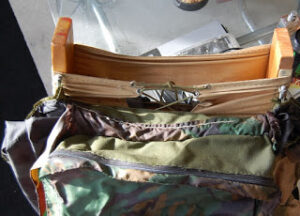A friend of mine was recently asking me about rucsacks. I suggested he take a look at alaskan packboards. Building your own is much easier than you might think. I know, because during my early twenties and of limited means I built one, with nearly all of the stitching done by hand (it shows!) . I’ve used this pack for a number of trips, the longest being a tour around Holland, Germany and Austria. I would have used it more were it not that externally framed packs are not a good idea if airport baggage handlers and carousels are likely to be involved. My European trip was during a threatened continental air traffic controllers’ strike so I travelled by train and overnight ferry.


The source for my rucksack plans was a British magazine called “SWAT” (Survival Weaponry And Tactics). Apparently identical illustrations are now available in a number of places on the internet.
The heart of the thing is the frame. I think this may have been made from common pinewood, since my knowledge of the properties of woods was rather minimal back then. You might be better off using ash or hickory, but my frame has never given me any problems. It can be built using very simple carpentry skills. The joins are “glued and screwed” for a belt and braces approach. The inside angles have a number of metal brackets added as reinforcement.


The carrying straps are made from 25mm and 50mm polyester or nylon webbing. The wider pieces are used for the shoulder section. The shoulder straps start on the inner side of the upper crosspiece, go under and up the back. These are glued into position and then secured by a metal plate on each side and secured with bolts. Add some extra glue for more strength. The metal plates were constructed from a door “fingerplate”. I suggest you put the bolt heads on the inner side, using countersunk heads if you can get them. Saw the shanks of the bolts down to the nut and upset the ends if you wish. The lower straps are attached to the outside bottom of the verticals and a piece of fingerplate bolted over them.

A piece of 25mm strap is sewn to the bottom of the 50mm pieces. Foam is wrapped around the 50mm pieces and covered with some waterproof nylon, in this instance salvaged from an old umbrella.
The wooden frame is given a number of coats of synthetic waterproof varnish.
The frame is surrounded by a cloth cover. This should be something breathable such as heavy duty cotton. This part is going to make contact with your back but creates an airspace between your back and the pack proper. The cover is laced taunt and screw-eyes inserted through into the verticals of the frame. These are used to attach the pack to the frame. Each screw-eye passes through an eyelet on the edge of the pack and then a rod is passed down through the screw-eyes. The original article suggested using flux-less wielding rods for the rods. I use two aluminium rods that a friend put screw threads and nuts on each end.

The design of the pack can be varied. Potentially you can make a number of different packs to work with the same frame. Mine was made mainly from condura. A double piece was sewn in the bottom and some umbrella nylon used to create a drawcord snowlock. Pockets were made from a combination of left over condura, PU-nylon and the cotton used for the frame cover. The latter was impregnated with wax to prevent water absorption.


The flap was made from a separate piece of waterproof PU-nylon with a camouflage pattern. This is one feature I might redesign. While this flap is very good at keeping rain out it is not loadbearing. A sales assistant in a bookstore attempted to bring me the rucksack by lifting it by the flap and tore the stitching. Last day of the trip and I have a sewing kit so not a major problem. The correct way to lift it is by the crosspiece of the frame. Either add an obvious carrying handle or add the PU-nylon over a condura flap formed as a continuous piece with the back of the sack. There is a large pocket sewn on top of the flap. One side of the pack has two pockets while the other has a long pocket suitable for taking a 2.5 litre plastic bottle of water (conscripted soda bottle!). This pocket can also take my large size platypus bottle.



The pack and frame are actually a lot lighter than you expect them to be. I suspect that some of my smaller, internally framed packs are heavier. I think I once worked out that the pack has a 110 litre capacity, but that was not including the external pockets! A pair of Dutch lads I travelled with were rather put out that my pack could carry tent, supplies, stove and sleeping bag all inside the main compartment, rather than having to strap stuff to the outside like they had to.
The long uprights of the frame take the weight off your back when you sit down.


Misadventures with the pack have been few. The cloth cover comes closer to the crosspiece than you expect. You can see a small hole in the cover where a bolt end rubbed through. I ended up sawing off and filing down the bolt shanks with my Swiss Army Knife while riding a German bus. The slot in the cover that the upper straps pass through was not quite right and I ended up having to reinforce that with the piece of green cloth visible (formerly part of a youth hostel’s curtain, if I recall!). I cannot remember if I added the green nylon strap reinforcing piece before or after this trip.